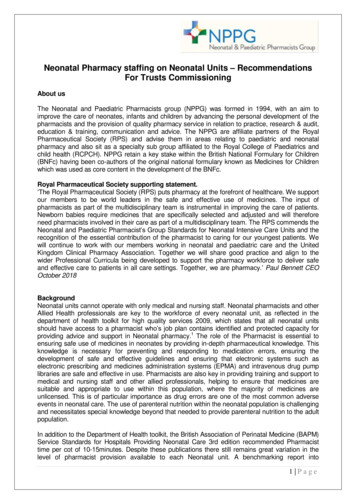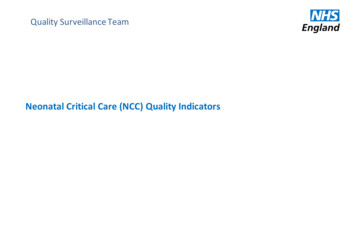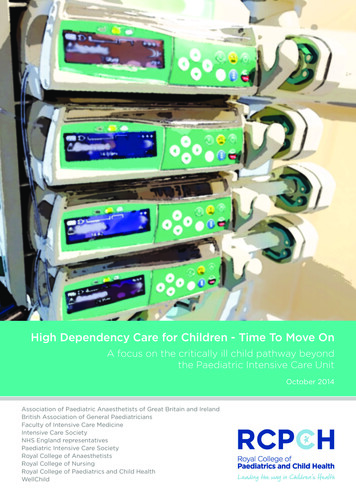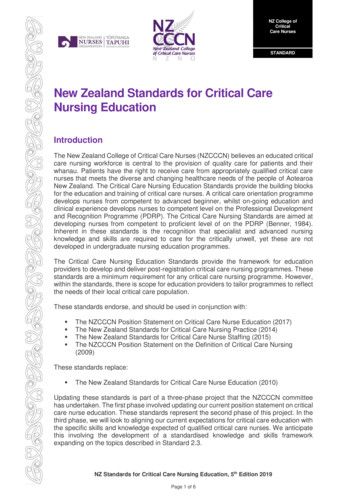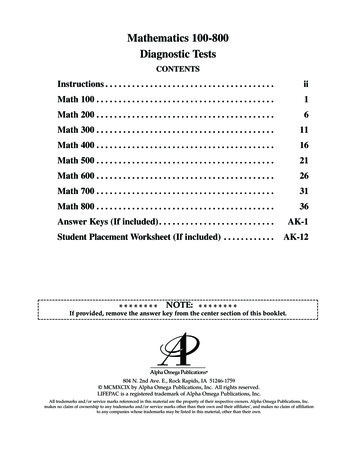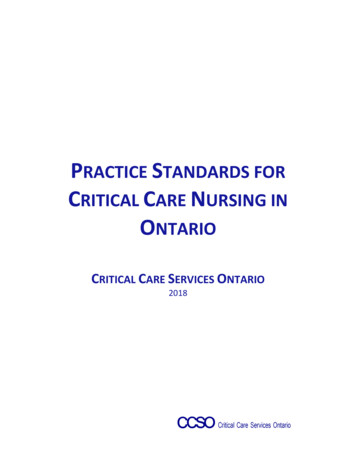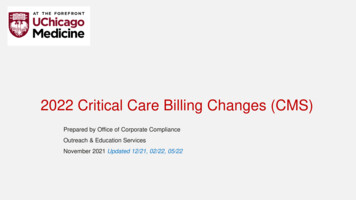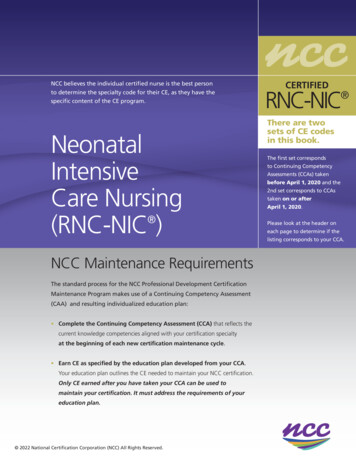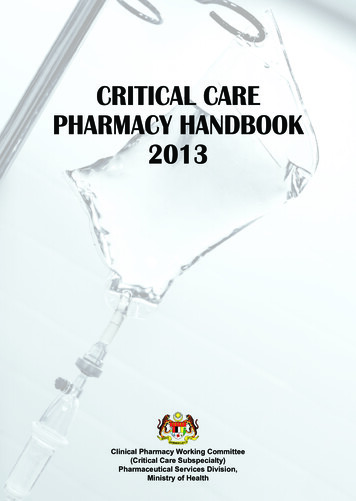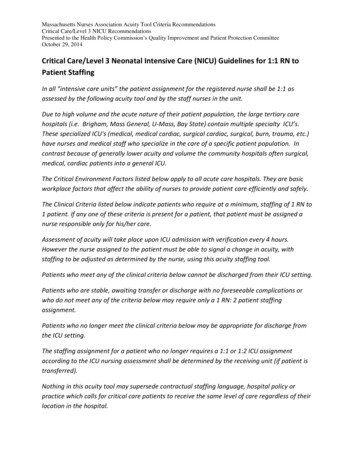
Transcription
Massachusetts Nurses Association Acuity Tool Criteria RecommendationsCritical Care/Level 3 NICU RecommendationsPresented to the Health Policy Commission’s Quality Improvement and Patient Protection CommitteeOctober 29, 2014Critical Care/Level 3 Neonatal Intensive Care (NICU) Guidelines for 1:1 RN toPatient StaffingIn all “intensive care units” the patient assignment for the registered nurse shall be 1:1 asassessed by the following acuity tool and by the staff nurses in the unit.Due to high volume and the acute nature of their patient population, the large tertiary carehospitals (i.e. Brigham, Mass General, U-Mass, Bay State) contain multiple specialty ICU’s.These specialized ICU's (medical, medical cardiac, surgical cardiac, surgical, burn, trauma, etc.)have nurses and medical staff who specialize in the care of a specific patient population. Incontrast because of generally lower acuity and volume the community hospitals often surgical,medical, cardiac patients into a general ICU.The Critical Environment Factors listed below apply to all acute care hospitals. They are basicworkplace factors that affect the ability of nurses to provide patient care efficiently and safely.The Clinical Criteria listed below indicate patients who require at a minimum, staffing of 1 RN to1 patient. If any one of these criteria is present for a patient, that patient must be assigned anurse responsible only for his/her care.Assessment of acuity will take place upon ICU admission with verification every 4 hours.However the nurse assigned to the patient must be able to signal a change in acuity, withstaffing to be adjusted as determined by the nurse, using this acuity staffing tool.Patients who meet any of the clinical criteria below cannot be discharged from their ICU setting.Patients who are stable, awaiting transfer or discharge with no foreseeable complications orwho do not meet any of the criteria below may require only a 1 RN: 2 patient staffingassignment.Patients who no longer meet the clinical criteria below may be appropriate for discharge fromthe ICU setting.The staffing assignment for a patient who no longer requires a 1:1 or 1:2 ICU assignmentaccording to the ICU nursing assessment shall be determined by the receiving unit (if patient istransferred).Nothing in this acuity tool may supersede contractual staffing language, hospital policy orpractice which calls for critical care patients to receive the same level of care regardless of theirlocation in the hospital.
Massachusetts Nurses Association Acuity Tool Criteria RecommendationsCritical Care/Level 3 NICU RecommendationsPresented to the Health Policy Commission’s Quality Improvement and Patient Protection CommitteeOctober 29, 2014CRITICAL ENVIRONMENTAL FACTORSNURSE COMPETENCY(based on the hospital’s competency assessment and RN familiarity with unit) Float Nurses are 20% or more of ICU staff Per Diem Nurses are 20% or more of ICU staff Travel Agency Nurses are 20% or more of ICU staff Nurses with less than 2 years’ experience in ICU nursing are20% are more of ICU staffGEOGRAPHY OF THE UNIT(whether layout allows for clear, rapid visibility of patient/monitor) Patient/monitor cannot be visualized from nursing stationPATIENT CARE EQUIPMENT Mobility/lifting device and adequate staff are not available tooperate equipment needed to care for patient (e.g., bariatric,traction, pronation bed, circular bed, Stryker bed) Required equipment is not available on the unit and functionalOPTIMAL ELECTRONIC DOCUMENTATION SYSTEM(e.g., no multiple and/or non-interfacing EMR systems) Electronic Records are not fully integrated/compatible Medication orders are not integrated into the medical recordMEDICATIONS *(e.g., availability on the unit and in appropriate doses) Medication doses are not pre-mixed or available in room/unitmedication cart/unit medication room Pain medications are not available in multiple dose strengths(which leads to wasting/needing another nurse to waste)SUPPORT STAFF IN PLACE(immediate availability on the unit) Pharmacist (24 hour) Unit based MD IV team/respiratory therapist Physician Assistant Unit Secretary Sitters (if needed) Aides /techs Patient transport services Travel team/coverageRESPONSIBILITY FOR DUTIES OFF THE ICU UNITCheck relevantbox below:YesNo
Massachusetts Nurses Association Acuity Tool Criteria RecommendationsCritical Care/Level 3 NICU RecommendationsPresented to the Health Policy Commission’s Quality Improvement and Patient Protection CommitteeOctober 29, 2014 Attendance is required at meetings or for education off theunitNurse off the unit for 15-30 minutes or more to attend to apatient (e.g., rapid response, stroke evaluation, patienttransport, patient support required during transport off unit orfor tests/procedures, e.g., interventional radiology)FAMILY SUPPORT Parent/family/guardian(s) available*Infant/Pediatric dosing, dispensing, drug preparation and effects on child have multiplecomplexities. See AL CRITERIAIf any of the following exist, 1:1 staffing must be implemented.Clinical CriteriaOne or more of the following clinical status indicators may be present in an ICU patient. If any ofthe boxes below are checked, that means 1:1 RN to patient staffing is required. If more than onecategory is present, higher intensity staffing may be indicated.CATEGORY OF CLINICAL STATUS OF PATIENTCHECKBOX IFPRESENTRN:PATIENTRespiratory1.Status post cardiac or respiratory arrest within the prior 12 hours1:12.Nitric oxide therapy for gas exchange (e.g., for respiratoryfailure, persistent pulmonary hypertension)1:13.Ventilator dependent infants requiring frequent intervention forrespiratory compliance/ chemically paralyzed for compliance(positioning, suctioning, trach care, sedation protocols, ABCDEbundle for weaning, frequent positioning, oral care)1:14Complex respiratory management including high frequencyventilation, noninvasive Cpap, Bubble Cpap requiring over 21%Fio2, changes to respiratory support to achieve goal minimums1:1
Massachusetts Nurses Association Acuity Tool Criteria RecommendationsCritical Care/Level 3 NICU RecommendationsPresented to the Health Policy Commission’s Quality Improvement and Patient Protection CommitteeOctober 29, 20145.Respiratory distress requiring intubation and administration ofpulmonary surfactants6.1:1New admissions requiring respiratory support/interventionsand/or hypovolemic supportCardiac1:17.Temperature below 97.6 or above 100.6 degrees1:18.Exchange transfusions1:19.Abnormally high bilirubin levels (above 17) requiringphototherapy1:110.Septic shock requiring continuous monitoring and multipleintravenous vasopressors with hemodynamic instability1:111.Hemodynamic instability requiring multiple vasopressors due toother than cardiac origin.1:112.Hemodynamic instability requiring frequent infusion(medication) titration and monitoring1:113.Active hemorrhage requiring multiple blood transfusions andvasopressor meds1:114.Acute organ failure (liver, kidney, brain) requiring constantmonitoring/intervention1:115.Unstable cardiac arrhythmias requiring frequent interventionssuch as defibrillation, transcutaneous pacing1:116.Unstable hyperglycemic patients on insulin drip requiringfrequent titrations and blood sugar determination1:117.Patient in cardiogenic shock with or without assistive devices1:118.Patients on devices, such as CVVH (continuous veno-venoushemofiltration (e.g. awaiting heart transplant)1:119.Patients requiring vasopressor meds1:1
Massachusetts Nurses Association Acuity Tool Criteria RecommendationsCritical Care/Level 3 NICU RecommendationsPresented to the Health Policy Commission’s Quality Improvement and Patient Protection CommitteeOctober 29, 201420.Metabolic acidosis or alkalosis (e.g. tricyclic overdoses, frequentABGs (arterial blood gases), monitoring for bicarbonateadministration, measuring urine and blood pH, monitoring forarrhythmias)1:121.Invasive lines such as pulmonary artery catheter (e.g. Swan Ganz,A-line, CVP catheters) requiring frequent monitoring andintervention (recalibrations, readings)1:122.Hemodialysis/peritoneal dialysis in unstable patient1:123Therapeutic hypothermia to treat right ventricular heart failureor on therapeutic hypothermia (“ice” protocol)1:124.Organ transplant patients1:125.Op-day open heart surgery patients during first 12 hours postop unless patient remains hemodynamically unstable1:126.Direct admission from OR if not going to PACU1:127.Patients undergoing procedures requiring sedation or paralysis(trach, scoping)1:128.Direct admission from operating room who is very unstableSurgical1:129.Unstable op-day major surgical patients with transposition of thegreat vessels, coarctation of the aorta, foramen ovale or othercongenital heart defects1:130.Op-day open heart surgery patients during the first 12 hourspostoperatively unless patient remains hemodynamicallyunstable1:131.Organ donation/transplant patients1:132.Patients undergoing procedures requiring sedation or paralysis(trach, scoping)1:1
Massachusetts Nurses Association Acuity Tool Criteria RecommendationsCritical Care/Level 3 NICU RecommendationsPresented to the Health Policy Commission’s Quality Improvement and Patient Protection CommitteeOctober 29, 201433.Direct admission from operating room who is very labile, e.g.open abdomenNeurological1:134.Severe neurological impairment requiring continuous monitoringof intracranial pressure.1:135.Active substance withdrawal with hemodynamic andneurological impairment and/or severe agitation compromisingpatient and/or staff safety1:136.Unstable hydrocephalus1:137.Inconsolable, highly irritable (screaming) neonate (e.g., inwithdrawal or crying for unknown or other reasons)1:138.Any infant experiencing witnessed or suspected seizures orunstable neurological statusGI (Gastrointestinal)1:139.Active GI (gastro-intestinal) bleeding requiring multiple bloodproducts1:140.Poor coordination of feeding mechanisms (e.g. sucking,regurgitation) requiring complex nutritional support or timeintensive feeding support)1:141.Complex nutritional and metabolic management including TPN(total parenteral nutrition)Skin42.Extensive dressing changes (e.g. drains requiring frequentmonitoring1:143.Frequent body repositioning or graded sensorimotorintervention required (e.g. to prevent skin breakdown, toprovide needed stimulation)Orthopedic1:144.Musculoskeletal abnormalities requiring frequent interventionGeneral1:1
Massachusetts Nurses Association Acuity Tool Criteria RecommendationsCritical Care/Level 3 NICU RecommendationsPresented to the Health Policy Commission’s Quality Improvement and Patient Protection CommitteeOctober 29, 201445.Any infant deemed unstable for current unit requiring transportto unit with higher level of care for further evaluation, surgery ormanagement1:146.Patients requiring treatments or procedures hourly or morefrequently1:147.Isolation precautions (transmission-based)1:148.Fragile infant exhibiting physiological stress reactions (e.g.motor, eye signals, skin color changes, facial/attention changes,hypertonicity, hypotonicity)1:149.Neonates with a gestation age of under 27 weeks1:150.Any previously stable infant with decompensating conditionsrequiring any of the following: X-ray, echo, EKG, r/o sepsisinterventions including blood work, lumbar puncture, urinecatheterization1:151.Infants requiring IV sedation, IV pain medication or paralytics1:1Admissions/Care Coordination/Education/Discharge Planning52.Impending neonatal death requiring intensive family support1:153.Two hours or more of patient intake (admission) or familyeducation, coordination of care, psychosocial support, socialwork, discharge planning intervention required1:1Massachusetts Nurses Association
Critical Care/Level 3 NICU Recommendations Presented to the Health Policy Commission's Quality Improvement and Patient Protection Committee October 29, 2014 Critical Care/Level 3 Neonatal Intensive Care (NICU) Guidelines for 1:1 RN to Patient Staffing In all "intensive care units" the patient assignment for the registered nurse shall be 1 .

